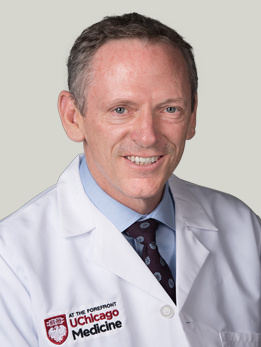[column width=”1/1″ last=”true” title=”” title_type=”single” animation=”none” implicit=”true”]
In honor of Liver Awareness Month, GIRF is spotlighting one of our very own Scientific Advisors and resident liver expert: Michael Charlton, MBBS. Dr. Charlton is Director of the Center for Liver Diseases and Co-Director of the Transplant Institute at the University of Chicago. Recruited by Dr. David Rubin after nearly 20 years at the Mayo Clinic, GIRF and its long-time support of research at the Digestive Diseases Center made the appointment even more attractive. “GIRF provides the ability to innovate and does that by giving us the fuel to do adventurous things.”
Dr. Charlton cites GIRF’s early support of research as an important foundation for later funding by the National Institutes of Health (NIH). “The NIH is cautious and wants a significant amount of preliminary data before it will invest in a research study.” One such project that received early funding by GIRF and has recently been funded by the NIH is the research Dr. Eugene Chang is conducting on the role of the microbiome in IBD. But the impact of this research reaches beyond IBD to hepatology and fatty liver disease. Dr. Charlton has collaborated with Dr. Chang and will present the findings next month at the American Association for the Study of Liver Diseases conference in Boston—the largest of its kind in the world.
Just how do liver, hepatology, and transplants relate to gastroenterology? “A lot of complications for liver, kidney, and heart transplants come from infections,” says Dr. Charlton, “these lead from the GI tract.” In fact, microbiome-related infections can be fatal for patients in surgical recovery. Luckily, with the collaboration of GI and liver physicians in an “offshoot of research done with GIRF funding,” these potential risks are being minimized.
This sort of interdisciplinary work, or “cross-pollinating,” as he puts it, is one of Dr. Charlton’s favorite things about the University of Chicago. He is currently part of a team of physicians working on a new form of therapy using T-regulatory cells (T-cells), which are found in the liver and have a calming effect on the immune system. This therapy, which involves isolating the T-cells, expanding them, and putting them back into the patient, is still in the early stages of being explored but may serve as an alternative for patients who are not responding to traditional IBD therapies. This is only one example of the interweaving between GI and hepatology research, and how the university continues to stand as a leader in innovation.
As Liver Awareness Month comes to a close, we asked Dr. Charlton what those in the GIRF community (and beyond) should do to keep their liver health at the forefront. His response, “If you have IBD, Crohn’s, ulcerative colitis, or other GI-related diseases, check in with your physician! Liver disease is silent; there are many digestive diseases, including IBD, that have a strong association with liver disease. Ask your physician if they are happy with your liver health.”
We are proud to have Dr. Charlton as one of our scientific advisors, and to include hepatology in the work of the GI Research Foundation!
[/column]

